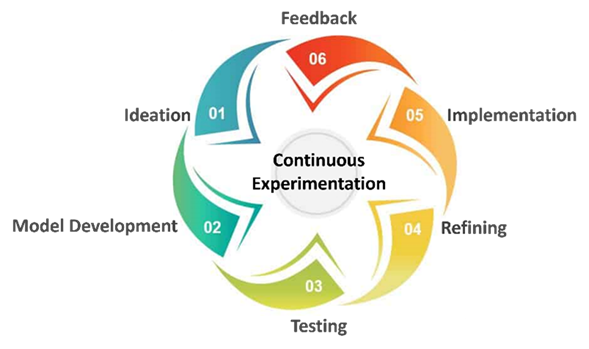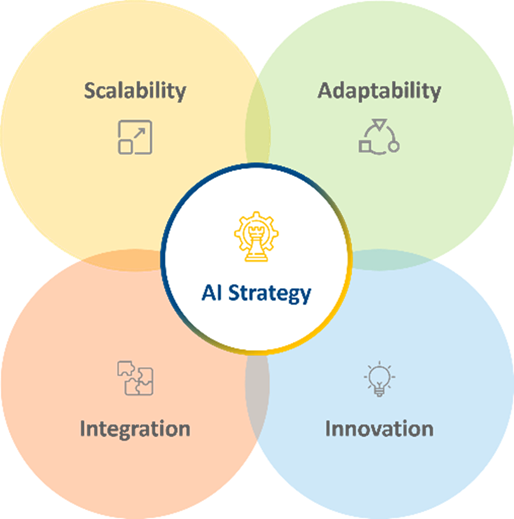Continuous Experimentation in Gen AI: Maximizing Impact for Enterprises
Industries today are continuously changing as artificial intelligence (AI), and generative artificial intelligence (Gen AI) are becoming more prevalent. However, many businesses run the danger of not realizing the full potential of these technologies if they don’t take a systematic approach to continuous experimentation.
Continuous experimentation is a methodical approach where enterprises tactically build solutions in an iterative yet incremental manner. Unlike traditional strategies, which mostly rely on building solutions once (with larger planning cycles and scaling the same static version over multiple years) to justify investment and efforts, continuous experimentation overcomes a lot of unknowns and inhibitions like fear of failure, running out of budgets, and many more to foster innovation at scale.
Enterprises that actively use AI claim a 20% boost in productivity, but 60% of them find it difficult to grow their AI programs, according to recent research from top analyst firms like Forbes1 and McKinsey2. This article discusses the importance of having a defined plan that is centered on ongoing experimentation to leverage the potential and capabilities of AI and Gen AI.
Why is a Continuous Experimentation Strategy Crucial?
Continuous experimentation is the key to optimizing the impact of any AI-led transformation. Gartner3 estimates that a lack of a defined strategy and an experimentation culture accounts for 54% of AI efforts in businesses that never make it past the pilot stage. Considering AI is still developing and has a dynamic impact on business operations, experimentation is essential; in an AI-driven future, a static approach will not suffice.
Businesses must include AI trials in their overall operations and strategy – various AI models, algorithms, and solutions must be tested as part of a continuous experiment and refined in response to results. Profitable businesses are aware that artificial intelligence isn’t a ‘set it and forget it’ technology. Rather, they continuously refine their AI models to make them consistent with their business objectives.

Fig 1.0 – Continuous Experimentation Cycle
The Importance of Scaling Experiments
An organized approach is necessary for scaling AI trials. The four essential components of a successful AI strategy are scalability, adaptability, integration, and Gen AI innovation.
- Scalability: According to McKinsey4, businesses that expand their AI trials across varied departments see a 30% increase in returns when compared to those that don’t. Organizations need to integrate AI across functions and go beyond isolated pilots if they want to expand.
- Adaptability: AI-related technologies are ever-changing. To remain competitive, businesses must continually experiment and adjust to new advancements.
- Integration: AI must be incorporated into the main business operations rather than be viewed as a stand-alone activity. Businesses that successfully incorporate AI into their processes have a higher chance of seeing notable improvements.
- Generative AI Innovation: Generative AI Innovation is the result of ongoing experimentation. Through continuous experimentation with novel AI applications, enterprises can uncover fresh prospects and stay ahead of the curve

Figure 2.0 Ideal Enterprise AI Strategy
Research-backed Strategies for Enterprises
Here are five tactics that have been supported by research to assist businesses in implementing continuous experimentation:
- Establish an experimentation-led innovation culture: Organizations must cultivate an environment that welcomes experimentation. To foster an atmosphere of ongoing learning, experimentation must be encouraged, even when it results in failures.
- Invest in AI talent and infrastructure: According to McKinsey5, businesses that have both competent personnel and a strong AI infrastructure have a 3.5x higher chance of seeing a return on their investments.
- Establish clear success measures: Medium6 claims that establishing success measures early on enables businesses to monitor the effects of AI projects and adjust experimentation as necessary.
- Meaningful collaboration: To scale AI, cooperation is essential. Organizations that collaborate across departments have a 2.2x higher chance of success when implementing AI, according to Gartner7.
- Say agile and flexible: In an AI ecosystem that is changing quickly, flexibility is essential. According to McKinsey8, successful businesses constantly modify their AI strategies to conform to market shifts.

Figure 3.0 Research-backed Approach to AI Adoption
Planning and Managing Budgets for Uninterrupted Delivery
To allocate a flexible budget for Gen AI innovation and Enterprise AI adoption, an organization’s leadership should consider it an investment in innovation rather than a fixed expense. To begin, set aside a certain portion of the total technology budget for Gen AI projects, with room for adjustment in response to preliminary results. A major chunk of the budget allocation goes into ensuring stability between key delivery resources and required tech infrastructure. So, trade carefully to prioritize the experimentation outcomes over anything else.
Sorting experiments into short-term (3-6 months) and long-term (12–18 months) ventures is an important tactic. A portion of the funds should be set aside to quickly test concepts that show promise, and another share for longer-term projects that have the potential to be game-changing. This structure encourages deeper innovation in addition to facilitating rapid victories. Moreover, keep emergency funds on hand in case unanticipated possibilities resulting from fruitful trials allow for the expansion of successful solutions. Setting up quarterly budget reviews will make it easier to reallocate funding, considering how AI is developing and based on the results of earlier projects. Businesses can remain adaptable and make sure they take advantage of new opportunities with Gen AI by approaching their budgets innovatively.
Where can Gen AI contribute?
The use of AI has surged in the last several years. According to Gartner’s recent press release9, 80% of businesses have already adopted or are in process of leveraging Gen AI in some capacity. This is a growing trend – organizations utilizing AI at scale are 2.5x more likely to report meaningful performance gains.
However, the advantages of AI go beyond technology. Businesses that use AI report gains in operational effectiveness, product innovation, and customer experience. Even with these advantages, growing AI initiatives and maintaining ongoing innovation remain two major obstacles that many businesses face.
Below are a few ways through which Gen AI can substantially enable and augment the experimentation process:
- Faster experimentation: Gen AI models can enable prototype ideation at speed, thereby assisting enterprises in evaluating multiple hypothesis and designs, without human intervention. This assists in informed decision-making, swift product development lifecycle, content generation for marketing, and other enterprise requirements. This, in turn, significantly boosts your speed-to-market.
- Synthetic Data Generation: To fine-tune a model for enterprise adoption, you need a huge dataset for iterative and incremental training. You can now generate this at will and scale, that too replicating diverse scenarios.
- Reinforced Learning: With the advancement in Large Language Model Ops (LLMOps), an active feedback loop can be created (through user feedback, AI testing AI, etc.) for continuous model optimization. So, while you continue to evolve dynamically, you still stay closer to your enterprise source.
Conclusion
Innovations in AI and Gen are transforming the landscape of businesses today. However, achieving success in this new age demands more than merely embracing the newest technologies. Companies need to cultivate an environment of ongoing experimentation, allocate resources to the appropriate talent and systems, and establish a definitive plan for expanding AI projects. By taking these steps, they can fully harness the capabilities of AI and Gen AI, creating significant change throughout their organization. IDC10 predicts that worldwide spending on AI technologies will surpass USD 500 billion by 2027, highlighting the increasing significance of AI in fostering business expansion. Companies that adopt a strategic stance towards AI and Gen AI will be in a prime position to benefit from this growth and steer their sectors into the future.
Are you ready to harness the power of AI for your enterprise? Start experimenting today and discover the transformative potential of Gen AI and other AI capabilities.
For more information, please reach out to: EAIBusiness.Advisory@LTIMindtree.com
References:
- Top AI statistics and trends in 2023, Forbes: https://www.forbes.com/advisor/in/business/ai-statistics/
- Economic potential of generative AI, McKinsey: https://www.mckinsey.com/capabilities/mckinsey-digital/our-insights/the-economic-potential-of-generative-ai-the-next-productivity-frontier#key-insights
- Gartner survey reveals 80% of executives think automation can be applied to my business decision, Gartner: https://www.gartner.com/en/newsroom/press-releases/2022-08-22-gartner-survey-reveals-80-percent-of-executives-think-automation-can-be-applied-to-any-business-decision
- Economic potential of generative AI, McKinsey: https://www.mckinsey.com/capabilities/mckinsey-digital/our-insights/the-economic-potential-of-generative-ai-the-next-productivity-frontier
- Modelling the impact of AI on the world’s economy, McKinsey: https://www.mckinsey.com/~/media/McKinsey/Featured%20Insights/Artificial%20Intelligence/Notes%20from%20the%20frontier%20Modeling%20the%20impact%20of%20AI%20on%20the%20world%20economy/MGI-Notes-from-the-AI-frontier-Modeling-the-impact-of-AI-on-the-world-economy-September-2018.ashx
Latest Blogs
A closer look at Kimi K2 Thinking, an open agentic model that pushes autonomy, security, and…
We live in an era where data drives every strategic shift, fuels every decision, and informs…
The Evolution of Third-Party Risk: When Trust Meets Technology Not long ago, third-party risk…
Today, media and entertainment are changing quickly. The combination of artificial intelligence,…




